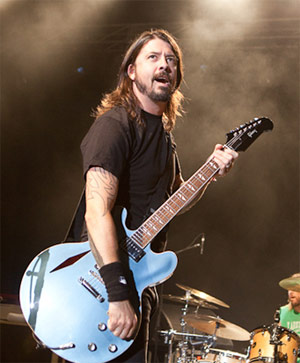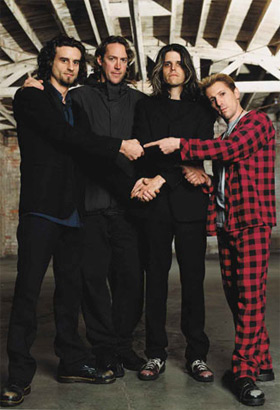The Vine live review: Roger Waters ‘The Wall Live’ in Brisbane, February 2012
A live review for The Vine. The full review appears below.
Roger Waters – ‘The Wall’ Live
Brisbane Entertainment Centre
Wednesday 1 February 2012If rock music is, at its heart, a mad combination of theatre, escapism and expression, then The Wall Live must be the warped apex of what rock music was designed for. It has to be said that this is an absurd concept: a band playing the entirety of an album released 32 years ago, while a 12-metre-high white wall is constructed between musicians and audience. It is the product of a brilliant imagination and a breathtaking commitment to realising an absurd concept, night after night, in a series of far-flung countries over the last 18 months. To think that one man envisioned all of this, notebook in hand, is incredible. The logistics of this tour and stage coordination alone is enough to make my head spin.
Tonight marks the 125th time that this show has been performed since its debut in September 2010. It is a spectacle; an event. Something to get dressed up for; in your best Pink Floyd t-shirt, if the majority of the crowd can be used as a measure. Shortly before the show starts, when everyone’s settled in their seats, a disembodied voice instructs us to turn off the flash on our cameras, as “all you’ll see is white bricks” in the captured image. And that it’ll mess with their projections. A lonely horn plays over the PA in a darkened room. It feels like misdirection. We’re looking around, into the abyss, wondering what’s going to happen.
Then: the band hit the first chord of ‘In The Flesh?’, pink fireworks launch from the stage into the ceiling, and Roger Waters emerges with his arms held aloft like a prize fighter, soaking in the applause while his band casually work through the track. A stagehand places a thick black trenchcoat upon his shoulders, he dons black sunglasses, and says into the microphone: “So you thought you might like to go to the show? / To feel the warm thrill of confusion, that space cadet glow?” By the end of the song, rows of sparks are cutting across the top and bottom sections of the stage, seemingly showering the band in a hail of white-hot fury; flag-hoisting Nazi look-alikes are being hoisted skywards on a mechanical lift; and a fucking airplane descends from the ceiling, somewhere above the sound desk, and knocks over part of the wall while flames lick its exterior. It is the most jaw-droppingly elaborate concert introduction I’ve seen – and I saw Kanye West last week. Someone behind me jokes, “We might as well go home now.”
Waters cuts a distinctive figure on stage. Clad in all-black, wearing white sneakers and luminiscent silver hair; but for the bass regularly held in his hands, he’s pure cat burglar. He is the archetypal bassist/frontman combo, perhaps the best we’ll ever see [Waters vs McCartney? – Ed]. And all of this belongs to him. It’s difficult to avoid discussing economics when it comes to this show. We’ve all paid stupid amounts of money to be here — albeit happily. Though he’s doing three shows at this particular venue, The Wall Live is a once-off proposition.
So here we are: in Waters’ world for two hours and change, including an intermission. All eyes upon a 68 year-old showman who is, clearly, in his element. This entire exercise is a business venture, yes; a very profitable one, as it were. But: this man doesn’t have to do this any more — he probably hasn’t for a very long time. Yet he endures, touring this absurd concept throughout the world, because he loves it. There can be no other explanation. And we love him for it, because… among many other reasons, at which other rock show in the world do you get to witness a plane crashing through a wall?
It is a wholly absorbing spectacle; at times, so much so that one wishes it to never end. There is a consistent narrative built into proceedings; they’re playing The Wall, of course, but much of the imagery and projections are taken from the film version. The wall gradually fills the stage over the first hour. By the halfway point, the animations and graphics being displayed are so mesmerising that it becomes a source of annoyance that the wall is incomplete, as we can’t see the whole thing. Build the damn thing quicker! Sixteen children emerge for the ‘Another Brick In The Wall’ medley, lending credence to the song’s timeless refrain. An enormous blow-up marionette ‘headmaster’ dances wickedly on the left of stage, wielding a cane, red eyes glowing eerily. Waters breaks the fourth wall (geddit?) a few songs in with the traditional “Hello Brisbane!” greeting. I kinda wish he didn’t, and kept in strict performance mode, at least until the intermission.
‘Comfortably Numb’, after the mid-set break – played before a completed wall – is something else. During the chorus, a spotlight is shone upon a singer atop the wall who reprises David Gilmour’s vocals; then, to his left, another spotlight is struck upon a guitarist reprising the same man’s solos. When Waters isn’t singing, he’s pantomiming so goddamn hard that even the nosebleed seats can’t misinterpret his gesticulations: hand-to-brow for “A distant ship’s smoke on the horizon”, hand to mouth for “Your lips move, but I can’t hear what you’re saying”, and – funniest of all – an index finger pointed downwards for “I cannot put my finger on it now”. Yet more evidence of a man in his element, loving every second of the attention. And then, the song’s closing guitar solo: the wall dissolves into an animated rainbow of falling bricks, while the guitarist wails away, faithfully recreating Gilmour’s finest moment. This could well be the most ridiculous moment of the show; one man shredding atop a 12-metre wall, with 13,000 pairs of eyes on him.
The band, for all their talent, are total wallflowers. They’re great, but faceless throughout the show – though he does introduce them one-by-one at the end, after the wall’s been knocked down. (An incredible sight in itself.) Their comparative anonymity is probably exactly how Roger wanted it. And clearly, what Roger wants, Roger gets. And we love him for it.
For the full review, visit The Vine.




 Andrew McManus Presents always set a per-transaction ticket limit for their shows in an attempt to curb scalping. The ticket limit “varies from show to show, but is always in place. We also monitor eBay and other similar auction sites,” the promoter says. “Anyone found selling our tickets for profit runs the risk of being reported and having their listing removed, or even having their tickets cancelled. I don’t think sites like eBay should intervene on their own, but if a promoter tells them to take something down, they should. And for the most part, they’re pretty good at doing that for you.”
Andrew McManus Presents always set a per-transaction ticket limit for their shows in an attempt to curb scalping. The ticket limit “varies from show to show, but is always in place. We also monitor eBay and other similar auction sites,” the promoter says. “Anyone found selling our tickets for profit runs the risk of being reported and having their listing removed, or even having their tickets cancelled. I don’t think sites like eBay should intervene on their own, but if a promoter tells them to take something down, they should. And for the most part, they’re pretty good at doing that for you.”
 Audience acceptance – the willingness to accept the performer’s wild, physical suggestions – is the difference between the average, static, one-way musical performance, and a memorable show that you’ll tell all your friends about.
Audience acceptance – the willingness to accept the performer’s wild, physical suggestions – is the difference between the average, static, one-way musical performance, and a memorable show that you’ll tell all your friends about.